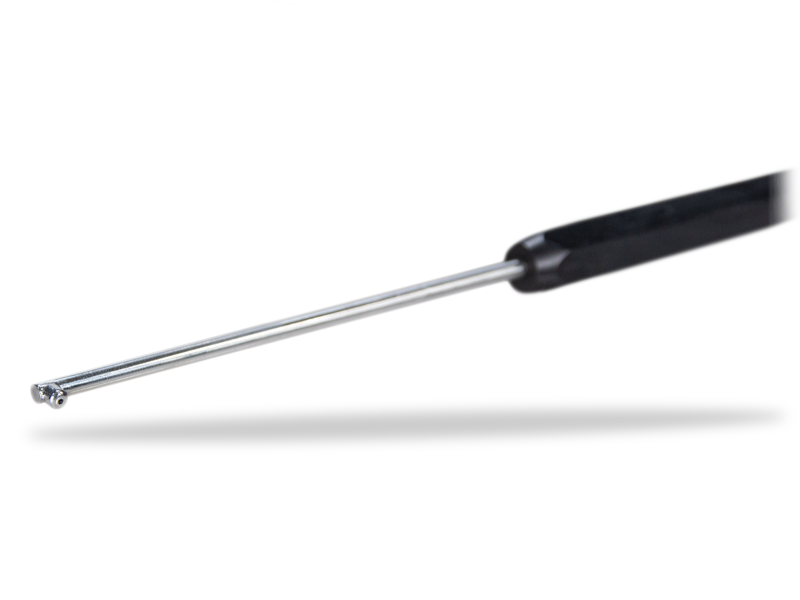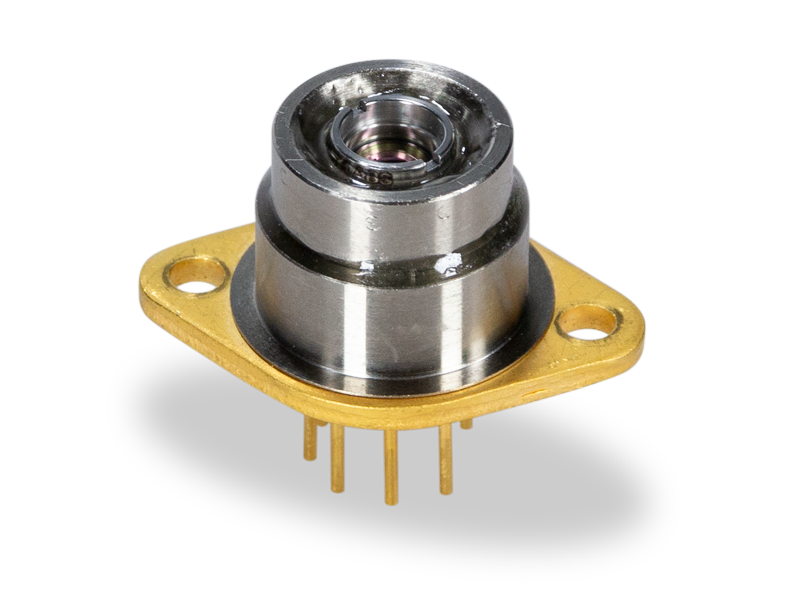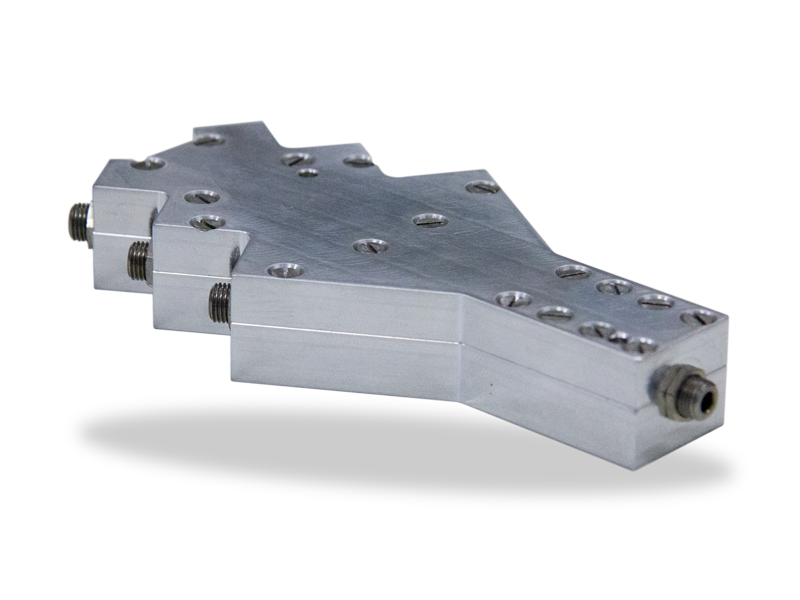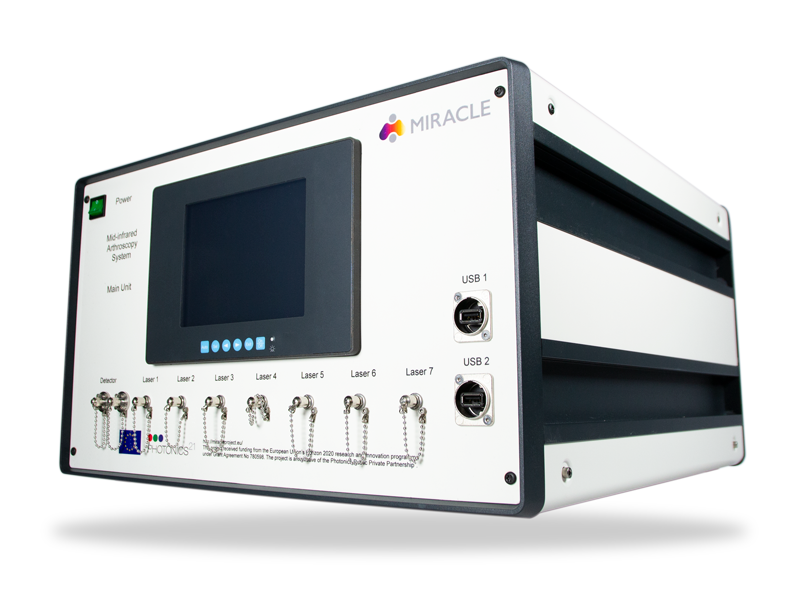Mid-infrared arthroscopy spectrometer system
MIRACLE team is developing and assembling multiple technologies in the first mid-infrared attenuated total reflection (MIR-ATR) instrument for arthroscopic use. The developed technologies include several innovative photonics components such as miniaturised MIR-ATR probe, QCLs and Main Unit electronics to integrate these unique elements.
Probe
Miniaturized MIR-ATR probe with innovative hook-like design facilitating transfer into clinical practice
The innovative MIR hook-shaped probe is based on the optical system of fibres and mirrors and satisfied the strict requirements from clinicians: tiny diameter (less than 3 mm), biocompatible materials and 90º angle hook shape. The above-mentioned features allow to reach distinct areas of cartilage for manual probing during the arthroscopy. Two technical designs were engineered by art photonics. The first design enables multiple use of the probe due to high-resistant diamond tip. Second design solves the problem of low signal due to extra-sensitive disposable fibre loop on the end for single-time measurement.


QCL
Quantum Cascade Lasers (QCL) with clinically relevant wavelengths to assess articular cartilage biochemical composition
The MIRACLE device is based on the molecular vibration of the molecules which constitute the cartilage tissue (for example, amides and proteoglycan). MIRACLE team has identified which wavelengths were clinically relevant to distinguish healthy from damaged cartilage. Seven wavelengths were selected and the corresponding QCL were developed and prototyped by the consortium partner nanoplus.
iBEAM
A unique integrated beam combiner for effective coupling of QCLs and MIR-ATR probe
The substrate-integrated hollow waveguide (iHWG) iBEAM provides efficient propagation and flexible steering of radiation from the visible into the far-infrared. Broad-band as well as narrow band radiation can be guided via highly reflective metallic waveguides, providing a high level of integration, a high damage threshold as well as the opportunity to directly implement gas cells from physics/chemical sensing within the wave guiding structures.

In particular, the iHWG-iBEAM serves as robust beam combiner platform for both spectral and power combination without the need for any dielectric mirrors or refractive gratings. Thus, ease of operation and broad applicability are are inherently provided without the need for further adaptations on special requests. Besides the MIR-ATR arthroscopy spectrometer system, the developed technology can be employed to several fields of application, such as medical devices, environment, pharmaceutics, biotechnology, process optimization and many more.

Main Unit
Mechanical construction and compatible electronics integrating all the photonics components
The integration of the MIR-ATR probe, QCLs, iBEAM and detectors requires specific electronics interface. The partner OptoPrecision has developed the electronic interface to connect all the components, focusing on low noise/signal ratio, fast measurement acquisition and minimizing signal loss. The assembling of the components in one main unit has been performed by optimizing space, but preserving the integrity of each component and avoiding overheating of the device. The main unit has been constructed also taking in account the user interface by adding USB ports and other features.
Modular and flexible multi-laser infrared light source and sensing unit for high quality (spectroscopic) measurements in the infrared region, comprising
- Up to 7 lasers (Interband-Cascade Lasers and/or Quantum-Cascade-Lasers) in TO-3 or TO-66 housings
The spectral coverage depends on the laser selection/specifications (typically in the range of 3-12 microns)
- The optical output power and the spectral features depend on the selected lasers
All 7 internal laser drivers are individual software-configurable
The lasers can be driven in CW or pulsed mode
- With pulse currents from 10mA to 4.5A
- Pulse repetition rates between 10kHz and 8MHz
- Pulse lengths between 10-255ns
Temperature stabilized (accuracy better 3mK), with operation temperatures between -10 … 40°C.
The free space beam of each laser is internally fibre-coupled and available on the front panel of the main unit through corresponding F-SMA output connectors
- Suggested c0ore diameter of the fibres is 240 um
The implemented radiation detection module
- Allows the simultaneous detection of all 7 lasers (operated in pulsed mode); one measurement every 25ms containing a set of 7 values (one for each laser)
- High sensitive and low noise radiation detection by the use of a peltier-cooled MCT detector (typical SNR > 2000) / other detector elements upon request
- The input beam has to be delivery through a fibre with a F-SMA connector
Software
The implemented software has a user friendly front-end (touch screen, optional USB-keyboard)
The measured data can be stored internally in plain text files, which are available later on through USB or network connection
The network capability allows a remote control and a data transfer to a connected server/cloud
- The system status and potential error messages are available as clear text information